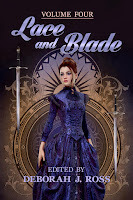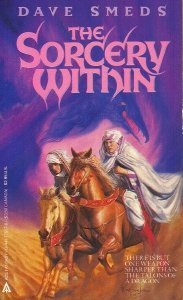Author Interview: Dave Smeds on "The Wind's Kiss"
 Dave Smeds has authored novels (including The Sorcery Within and X-Men: Law of the Jungle), screenplays, comic book scripts, and articles, but is best known for his short fiction. His work has graced the pages of Asimov's SF, F&SF, Realms of Fantasy, and a plethora of anthologies, including most particularly the Sword and Sorceress series and the Lace and Blade series. His wonderful short fiction piece, "The Wind's Kiss," first appeared in Lace and Blade 4. It's a marvelous story, exquisitely written, full of pitch-perfect heart. Now it's also available in Dave's collection Swords, Magic, and Heart (see the cover below).
Dave Smeds has authored novels (including The Sorcery Within and X-Men: Law of the Jungle), screenplays, comic book scripts, and articles, but is best known for his short fiction. His work has graced the pages of Asimov's SF, F&SF, Realms of Fantasy, and a plethora of anthologies, including most particularly the Sword and Sorceress series and the Lace and Blade series. His wonderful short fiction piece, "The Wind's Kiss," first appeared in Lace and Blade 4. It's a marvelous story, exquisitely written, full of pitch-perfect heart. Now it's also available in Dave's collection Swords, Magic, and Heart (see the cover below). Deborah J. Ross: Tell us a little about yourself. How did you come to be awriter?
Dave Smeds: Iloved fiction from an early age. I was particularly drawn to stories ofimaginary worlds, or at least by settings that were in effect imaginary, suchas Mars as depicted by Edgar Rice Burroughs. At age fifteen, it occurred to meI might be able to write a short story or two. I did that. The result was crap,of course, but every time I did another story or fragment of a novel, I could seehow to improve. (It was, as you might imagine, REALLY OBVIOUS how I couldimprove.) I felt driven to eventually write something at a level I’d want toread if someone else had written it.
DJR: Whatinspired your story in Lace and Blade 4?DS: There is a great deal of me in “TheWind’s Kiss.” The fulfillment I feel in being a father. The contemplation ofthe pioneer life led by my ancestors as they moved westward, often literallydwelling right at the edge of civilization, first settlers on the scene. Thevital need in our hearts for passion between, and admiration of, one’s lover.However, there is also a more specific inspiration for this particular piece.In August, 2016, I was finally able to take a journey through Nebraska. For thefirst time in my life, and quite possibly for the last time, I visited thegrave of my great great grandmother, Marancy Alexander Warner. The land therehas a windswept, deeply conscious aspect. I wanted to install that presence inmy fiction as soon as possible, and as it happened, that sort of setting andmood was perfect for what I wanted to write for Lace and Blade 4.
DJR: Whatauthors have most influenced your writing? What about them do you findinspiring?DS: In the early days, I never thought ofmyself as deeply influenced by any particular author, except perhaps in thesense that I loved to write sword-and-sorcery, and back then, anyone doing thatwas standing on the shoulders of Robert E. Howard and J.R.R. Tolkien. Inretrospect, I see L. Frank Baum’s influence upon the way I structure a story.Baum did not write The Hero’s Journey. He wrote The Heroine’s Journey. That isto say, he wrote books in which the protagonist — usually a girl — makesalliances, as opposed to the Campbell paradigm where a young man pulls himselfup by the bootstraps, stands alone, and takes sole credit for defeating anantagonist. I prefer the complexity and subtlety of The Heroine’s Journey.
DJR: Why doyou write what you do, and how does your work differ from others in your genre?DS: At first I wrote to prove I could doit. Next I wrote to earn money. Both motivations, in my view, demanded that Iwrite the best work I could, so in that respect, I have no regrets. But I writenow with the awareness that an author of fiction has an obligation to injectmeaning into an essentially meaningless universe. That’s our job as humanbeings. We are creatures of pattern recognition. It’s our chief survival trait.But a fiction writer must do it better than anyone. Hard to do. However, atthis point in my life I’ve proven I can write many types of fiction and I’m ata point where I don’t need the money, really, so what keeps me putting thewords down on the chance it will move a reader in a way that would not havehappened otherwise. As said, hard to do. I try anyway.
DJR: How doesyour writing process work?DS: My process would drive any other writernuts, I suspect. The ideas — whether it is for a scene, a character, a setting,a plot, a premise — bubble up and I go with what fascinates me at the moment. Isee the whole story as a piece and fill in the pieces almost randomly as ifassembling a jigsaw puzzle. I might write the ending first. I might write alittle bit that fits two-thirds of the way along. Often I will start at thebeginning, but it’s just about unheard of that I proceed from page one to theend in chronological order. I think that’s happened only three or four times inforty-seven years of writing, and only with very short pieces.
DJR: What haveyou written recently? What lies ahead?
 DS: In terms of output, I’ve slowed downtremendously in the past fifteen years. Lately quite a bit of my creative work has been on the art side of my career, doing covers of other authors’ books. For example, I did the cover for Lace and Blade 4. Since 2006, aside from reprints andadaptations, my fiction has appeared in either the Lace and Blade seriesor the Sword and Sorceress series. Of those, I’ve been absent from onlytwo volumes, namely Lace andBlade 2 and Sword and Sorceress 30, and I did the cover for the latter. Iplan to get back to doing spec short fiction for a variety of markets now thatI’m at last on the verge of completing The Wizard’s Nemesis, thefinal volume of my War of the Dragons trilogy.
DS: In terms of output, I’ve slowed downtremendously in the past fifteen years. Lately quite a bit of my creative work has been on the art side of my career, doing covers of other authors’ books. For example, I did the cover for Lace and Blade 4. Since 2006, aside from reprints andadaptations, my fiction has appeared in either the Lace and Blade seriesor the Sword and Sorceress series. Of those, I’ve been absent from onlytwo volumes, namely Lace andBlade 2 and Sword and Sorceress 30, and I did the cover for the latter. Iplan to get back to doing spec short fiction for a variety of markets now thatI’m at last on the verge of completing The Wizard’s Nemesis, thefinal volume of my War of the Dragons trilogy.DJR: Whatadvice would you give an aspiring writer?DS: Forget about it. Quit right now. I don’twant any more competition.
 Dave Smeds hasauthored novels, short fiction, comic book scripts, and screenplays in avariety of genres including science fiction, contemporary fantasy, superhero,martial arts, horror, and erotica, but he is particularly at home when writingimaginary-world fantasy, as in his books The Sorcery Within and TheSchemes of Dragons and his stories in over a dozen volumes of Swordand Sorceress. "The Wind's Kiss" is another such work, set entirelyin a world of its own; however, the premise and the themes and the images arevery much drawn from a personal wellspring, including his experience of being afather. The setting is directly inspired by a 2016 visit he made to the site ofthe pioneer homestead on the Nebraska prairie where his great greatgrandmother, Marancy Warner, finished her life. As he stood at her grave --unmarked, but Dave knew where it was -- a breeze stirred.
Dave Smeds hasauthored novels, short fiction, comic book scripts, and screenplays in avariety of genres including science fiction, contemporary fantasy, superhero,martial arts, horror, and erotica, but he is particularly at home when writingimaginary-world fantasy, as in his books The Sorcery Within and TheSchemes of Dragons and his stories in over a dozen volumes of Swordand Sorceress. "The Wind's Kiss" is another such work, set entirelyin a world of its own; however, the premise and the themes and the images arevery much drawn from a personal wellspring, including his experience of being afather. The setting is directly inspired by a 2016 visit he made to the site ofthe pioneer homestead on the Nebraska prairie where his great greatgrandmother, Marancy Warner, finished her life. As he stood at her grave --unmarked, but Dave knew where it was -- a breeze stirred.
Published on February 21, 2025 01:00
No comments have been added yet.



